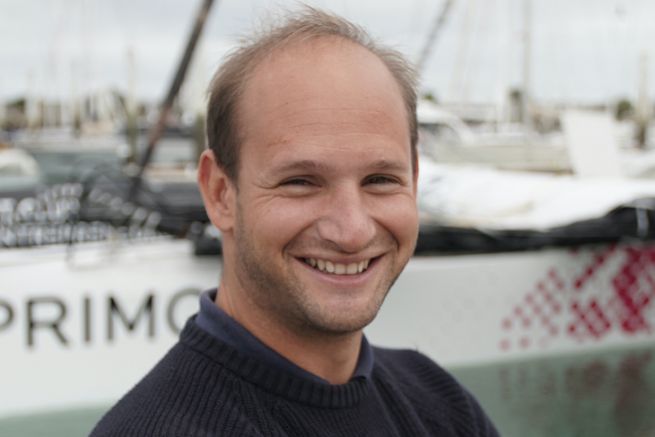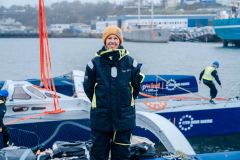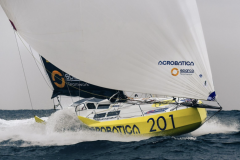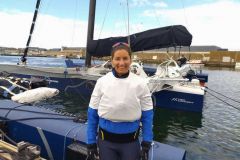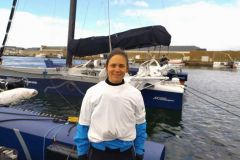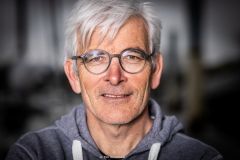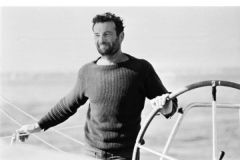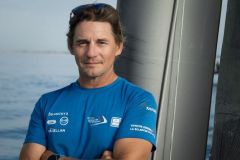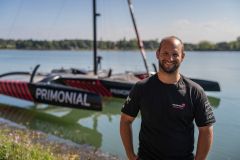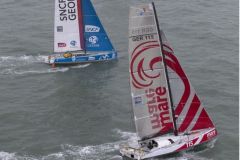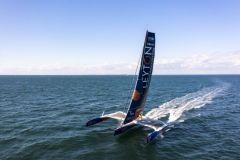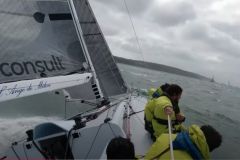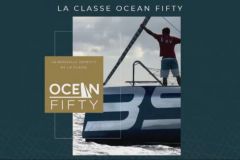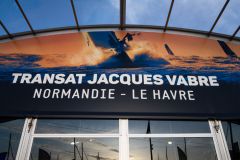The discovery of ocean racing by the Mini
In his nursery, posters of his idols decorate the walls. It is neither singers nor actors who make Sébastien Rogues' eyes shine, but navigators. Lionel Lemonchois, Michel Desjoyeaux... He too dreams of becoming a professional offshore sailor, but he doesn't dare to hope so.
Especially since it does not have a conventional route. "I didn't really go through the federal curriculum. I started ocean racing by doing the Mini 6.50 in 2007. I was a student and I dreamed of one day participating in the Mini Transat."
It was then that he met a sponsor for his first Mini Transat in 2009, that he ran in series, with an 8th place finish. The current goes well and it replaces for two other seasons, but this time proto. "It was on the Mini 716, a Lombard proto, built by Henry-Paul Schipman, called Maisons de l'Avenir." It was then sponsored by Éole Génération and GDF Suez.
In 2011, he will leave for a new transatlantic race. "I won the first stage, but I had to give up on medical grounds."
After two seasons in Mini which allowed him to acquire "the foundations of his profession and to lay the foundations for larger projects ", Sébastien decides to think bigger.
Want to sail on a larger boat
"Going Mini is a way to validate that you are made for ocean racing. It's a nut shell, with no comfort where you sail wet H24... When you go Mini, you often have no or few budgets and everything is done very quickly. But I realized I wanted to compete. I had also managed to start my own small business and understand how it worked."
Because Sébastien is not only a sailor, he is also an entrepreneur who manages his sailing projects. "I learned to manage a company through my Mini projects. I managed the relations with the partners, knew perfectly the route of the Lorient-Paris TGV... I understood the job and I wanted a bigger boat."
A first Class40
In 2012, still in partnership with Éole Génération and GDF Suez, it will go to Class40. He participated in his first race, the Solidaire du Chocolat with Bertrand Delesne and finished 5th. He then competed in the Atlantic Cup on the West Coast of America and then in Quebec - Saint-Malo with Sébastien Marsset and Rémi Beauvais, where the trio finished third.
In anticipation of the upcoming races - and in particular the Transat Jacques Vabre 2013 and the Route du Rhum 2014 - Sébastien would like a more recent boat.
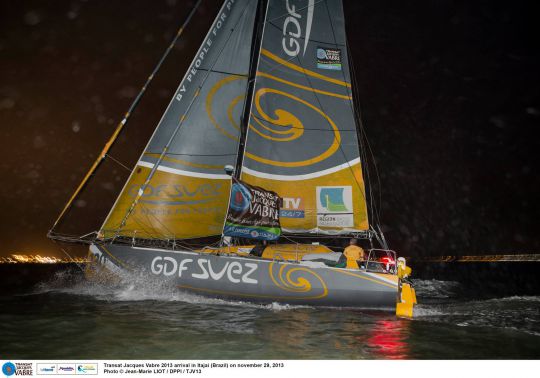
A second Class40 and two winning seasons
"I'm a competitor and I wanted to become the guy to beat. I then made my first decision as a company manager, leaving the sailor behind. I had to bear significant financial risks to build a Mach40 2 on a Manuard plan."
Quickly after its launch, it won all the crewed coastal races in which it competed: SNSM Record, ArMen Race and Guyader Grand Prix. He then won Les Sables - Horta with Armel Tripon, followed by the Rolex Fastnet Race and the Transat Jacques Vabre.
"This boat was amazing. He accompanied me for two wonderful years. It was a joy without a name. Happiness to imagine it, to have it built, to see it "born" at JPS Production. But since all great stories have an end, I missed a victory."
Indeed, the 2014 Route du Rhum escapes him. While he had just assisted Pierre-Antoine on Olmix, his boat broke up and prevented him from continuing the adventure. "After two years of uninterrupted victories, the one in the Route du Rhum escaped me. I had to be disappointed."
That year, it was Loïck Peyron who won the Ultim race. He is 54 years old and has been trying for years to hang the mythical transatlantic race on his victory board. "It puts a lot of things into perspective. It's a career a Route du Rhum, which is open to very few people. It would have been too easy to win like that."
Acquire foil experience
Sébastien then decided to move on to something else: foils. "I wanted, through my sports projects, to acquire the experience of the foil and learn all the components around flying boats by sharing them with my team."
The 34th edition of the America's Cup, which is being held in the AC72, makes him jubilant. " There was something going on at dingue?! And either you were part of it or you were doing the thing instead of being able to navigate it."
The skipper of the Multi50 Groupe Primonial stops the offshore and monohull to focus on these foil racks. The only flying boat that was practiced with reasonable budgets at the time was the GC32, a 12 m long flying catamaran capable of top speeds of 40 knots.
"It was a big professional gap. I was moving from the world of ocean racing in monohulls, to solo or double-handed races of about twenty days at the helm of a flying multihull, to 20-minute regattas, held all over the world."
The idea is not to perform, in view of the competitors, but to try to evolve in a sporting field, without "being too bad." It is 2015, and this is the beginning of the GC32 circuit, which has since grown in importance. "I was well aware that I could never have the technicality of the helm and the sensations of the other crews. It's something we don't develop as much in ocean racing."
Finally, these three years on the circuit of flying boats allow him to understand "how a boat flies, to manage 3D flight, to understand the action of sails on foils." Today, Sébastien understands and has integrated the mechanism of flight on a boat of 10 m as well as 30 m.
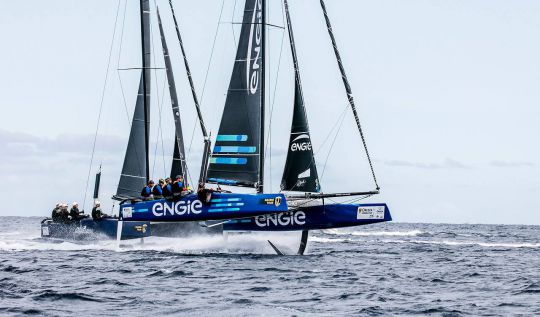
Bringing together the offshore and the inshore
Happy with these years spent "flying", Sébastien decided to bring together the two worlds in which he had evolved. The first is offshore, which he practiced in Class40 and Mini and the second is inshore, which he discovered in GC32. And for him, the most suitable boat is the Multi50.
"It's a project that was born on the Rolex in 2013. On arrival in Les Scilly, on starboard tack upwind, we pass the Ultimate Banque Populaire (now Spindrift). He had already turned the Fastnet and was arriving in Plymouth. At that moment, I thought I would never do a monohull again. It's strategically different, you move as you wish between the different weather systems and the time/speed ratio is not the same as in a monohull."
Passionate about ocean racing and multihulls, he then decided to embark on a Multi50 project, the class that gives him the best access to navigation on several hulls.
"As much in terms of budget as in terms of access to the most beautiful offshore races. They are simple but dangerous boats, a mix between a Class40 and a GC32. Due to their "reduced" dimensions of 15x15 m, they are super engaged boats. They are also light - 4 tonnes - and can capsize in 15 knots of wind. We have a kind of Damocles sword over our heads. As a result, it is the most beautiful school of offshore multihulls. I don't know of a boat more fickle than these and the day we will change, we'll have faster boats, but wiser in terms of nervousness."
The birth of the partnership with Primonial
Sébastien must first find a new partner. GDF Suez terminated their contract in 2017. He then met Primonial, a "a company with great energy." To diversify its sponsorship strategy, Sébastien decided to launch the Yacht-Club des entrepreneurs, a club with about thirty partners.
"When you have a single sponsor, as I did with Engie, who contributes 95% of his turnover, it's hard to live with when he leaves. The Yacht-Club allows VSEs and SMEs to participate in offshore racing. It's working great. I thought I was starting a partner club and I feel like I started a start-up. Our digital architecture seems to work and can be applied to other media, with potential behind it. There is something for everyone: experience, navigation, visibility."
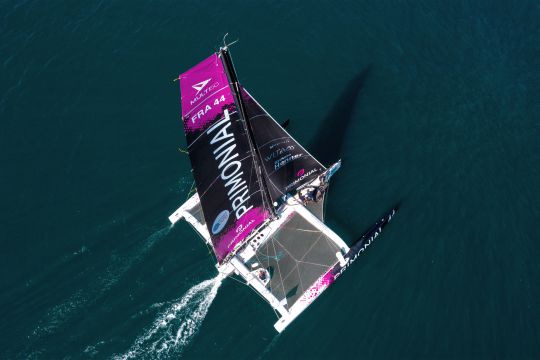
Primonial, the former Chocolate Reauthority, winner of the 2018 Route du Rhum
Thanks to Primonial and its Yacht-Club of entrepreneurs, Sébastien was able to buy the former Réauté Chocolat, Multi50 winner of the 2018 Route du Rhum with Armel Tripon.
"It's a great boat, very powerful. We saw it on the Grand Prix this summer. It was also the boat with the best quality/price ratio on the market. It also has the most important evolutionary capacity at the moment. The Multi50 financing model is not simple. New boats are quite expensive and if the operating price is accessible to partners, we cannot afford significant depreciation costs. If you buy too much, you sell at a loss. The price of Réauté was appropriate for my budget."
With a project started late - the boat was launched at the beginning of August 2019 - it was not possible to think about optimisation right away. Anyway, the boat is "crazy, taken in hand by my friend Armel Tripon who did a huge job in interview and a magical preparation. It allowed us to get right into a sports approach."
After a summer of sailing, Sébastien was able to test his new boat and has already thought about ways to optimize it. "Today, I know what to optimize. Two months ago, I had no idea. The boat is already running quite well, but the mast is obsolete. It will have to be changed to improve performance. I also have the ambition to change the floats to bring the boat back to weight and have a better drag. He has great evolutionary skills."
A Multi50 class in development
This year, the Multi50 Class is not very well represented with only three boats at the start of the Transat Jacques Vabre 2019. "At the same time there will be no other multihulls." However, next year, the situation will be different since there will be 8 boats in the class.
A configuration that suits Sébastien well, to make his hole in the Multi50. "We are happy to integrate the class under these conditions, with few boats, which allows us to be less overwhelmed. We take things in a simpler way."
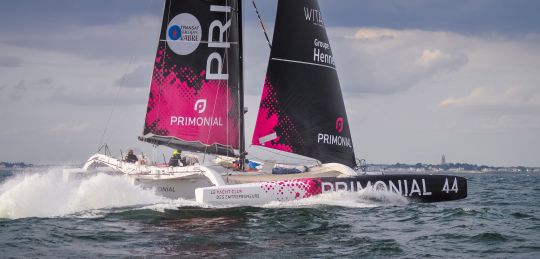
An outsider to watch out for
For the Transat Jacques Vabre, Sébastien will be accompanied by Matthieu Souben. If they are real competitors and only take part in a race with victory in sight, they know that it's a little different on this transatlantic race.
"There's only one place and you have to know how to look around you. I have two competitors who are multihull specialists. Thibaut is the favourite with a new boat and he is an excellent sailor. At his side, Gilles Lamiré and Antoine Carpentier have the most successful boat in the class. Gilles has extensive experience in Multi50 and Antoine has extensive experience in ocean racing. He's also known as the guy who'll never give up."
Despite a rather short but efficient preparation, Sébastien and Matthieu know that they are sailing on a good boat. Their place?? "The outsider who shouldn't be left with too much room, otherwise he'll eat tout? ! Of course we're not favourites, but I'm preparing to be in the lead. We know where to go, the pace we will set for ourselves and the one we will not exceed. The multi50s are dangerous, especially when you sail above your abilities or level of play.
But there is one unknown issue that remains to be resolved. "We don't know what a Transat Jacques Vabre rhythm is in a multihull. Can we make it tenir??" On the scale of a transatlantic race, Sébastien knows that not everything will be decided in four days.
For routing - the Multi50s are allowed to be accompanied by a land-based router - Sébastien calls on Julien Villion. "It's a great router, with a lot of experience, bottle-fed by Jean-Yves Bernot. He's our third partner. In Multi50, the pace is more complicated, and Julien will follow us on the road and help us find the most optimized route to get through the lows, the doldrums or the trade winds."
"Our team is efficient and we want to go far. We have the knife between the dents?! We starved to death, rested and ready, while the battle commence?! Our only real goal is to get to Salvador. We did our best, we sailed like never before and we won't have any regrets. If we do all this, we should be in the right package. Then it'll be about details." concludes Sébastien.
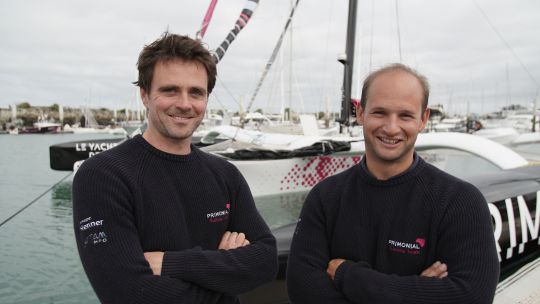
Dreams of Jules Verne
If Sébastien has just joined the Multi50 Class - "the first step of his dream" - what he dreams of accomplishing is a crewed round the world trip. "My dream is the Jules Verne. That's what makes my heart beat."
The skipper would like to have the opportunity to set up a project to try to break this record, but above all to have the opportunity to cross the starting line. "It's the best thing you can do in ocean racing. As far as I'm concerned, it's my absolute Grail. That's what drives me on a daily basis, my little inner flame."
Sébastien also knows that it is one of the hardest projects to set up, one of the most expensive, on boats that cost even more.
For the Transat Jacques Vabre 2019, Sébastien will be leaving with Matthieu Souben. A choice that was not really a choice since the two sailors have known each other for more than 10 years and get along very well. "He has a double experience as a sailor and engineer/sail designer. He brings me his experience in Formula 18 or Multi50 or Maxi80 with Lionel Lemonchois. He has an incredible experience in multihulls, he is a prodigy of the track. We are very complementary."
